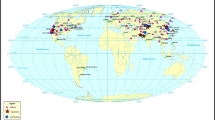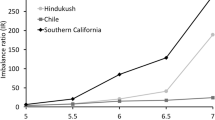Abstract
Logit analysis is widely used for binary data classification in geoscience. In this study, logistic regression was used as a tool for deriving the binary classifier of tsunamigenic and non-tsunamigenic earthquakes for near-source early warning. The catalogue of submarine earthquakes and tsunami database were merged into one seismic database, in which an additional binary variable associated with the tsunamigenic class (true or false) was assigned to each seismic event. The training dataset consisted of 712 M6.0+ submarine earthquakes, including 80 tsunamigenic and 632 non-tsunamigenic events that occurred in the northwestern part of the Pacific Ocean from 1960 to 2020. The target area has already experienced significant and catastrophic tsunamis. The best performance metrics were archived with the predictors given by the earthquake magnitude, logarithm of the source depth and the seafloor depth in the epicenter location. The current analysis clearly showed that the data-driven logit model significantly improved the performance metrics of the threshold magnitude criteria that are widely used by tsunami warning agencies. Authors suggested that logit-based binary classifier led to improve the tsunami alert efficiency in the Northwestern Pacific Ocean.







Similar content being viewed by others
Data Availability
The primary data used in the current study are freely available at the indicated sources. Data that result through preprocessing are available as electronic supplementary material.
Code Availability
Visual Studio Code Source Editor and Python programming language were used in the current study. The following Python libraries were employed: NumPy, Matplotlib, Scikit-learn and Global-land-mask. Code is available upon request.
References
Abe, K. (1979). Size of great earthquakes of 1873–1974 inferred from tsunami data. Journal of Geophysical Research, 84, 1561–1568.
Amato, A., Avallone, A., Basili, R., et al. (2021). From seismic monitoring to tsunami warning in the Mediterranean Sea. Seismological Research Letters, 92, 1796–1816. https://doi.org/10.1785/0220200437
Baba, T., Hirata, K., & Kaneda, Y. (2004). Tsunami magnitude determined from ocean-bottom pressure gauge data around Japan. Geophysical Research Letters, 31, L08303. https://doi.org/10.1029/2003GL019397
Bernard, E., & Titov, V. V. (2015). Evolution of tsunami warning systems and products. Philosophical Transactions of the Royal Society A, 373(2053), 20140371. https://doi.org/10.1098/rsta.2014.0371
Boschetti, L., & Ioualalen, M. (2021). Integrated tsunami intensity scale based on maxima of tsunami amplitude and induced current. Natural Hazards, 105, 815–839. https://doi.org/10.1007/s11069-020-04338-5
Chicco, D., & Jurman, G. (2020). The advantages of the Matthews correlation coefficient (MCC) over F1 score and accuracy in binary classification evaluation. BMC Genomics, 21, 6. https://doi.org/10.1186/s12864-019-6413-7
Cienfuegos, R., Catalán, P. A., Urrutia, A., Benavente, R., Aránguiz, R., & González, G. (2018). What can we do to forecast tsunami hazards in the near field given large epistemic uncertainty in rapid seismic source inversions. Geophysical Research Letters, 45, 1–12. https://doi.org/10.1029/2018GL076998
Conn, A. R., Gould, N. I., & Toint, P. L. (2000). Trust region methods (pp. 169–200). SIAM.
Cramer, J. S. (2002). The origins of logistic regression. Tinbergen Institute working paper. No 2002–119/4. pp. 167–168.
Davies, G. (2019). Tsunami variability from uncalibrated stochastic earthquake models: Tests against deep ocean observations 2006–2016. Geophysical Journal International, 218(3), 1939–1960. https://doi.org/10.1093/gji/ggz260
Finch, R. H. (1924). On the prediction of tidal waves. Monthly Weather Review, 52(3), 147–148.
Gusev, A. A. (1991). Intermagnitude relationships and asperity statistics. Pure and Applied Geophysics, 136, 515–527.
Gusiakov, V. K. (2011). Magnitude-geographical criterion for operational tsunami prognosis: Analysis of application in 1958–2009. Seismic Instruments, 47, 203. https://doi.org/10.3103/S0747923911030078
Gusyakov, V. K., & Chubarov, L. B. (1987). Numerical simulation of tsunami excitation and propagation in the coastal zone. Izvestiya AN SSSR. Physics of the Earth, 21(11), 53–64.
Harrell, F. E. (2015). Binary logistic regression. In: Regression modeling strategies. Springer series in statistics. Springer, Cham. https://doi.org/10.1007/978-3-319-19425-7_10
Iida, K. (1963). Magnitude of tsunamigenic earthquake, aftershock area and area of tsunami origin. Geophysical papers dedicated to prof. Kenzo Sassa.
Iida, K. (1970). The generation of tsunamis and the focal mechanism of earthquakes. In W. M. Adams (Ed.), Tsunamis in the Pacific Ocean (pp. 3–18). East-West Center Press.
Ivashchenko, A. I., & Go, C. N. (1973). Tsunamigennost’ i glubina ochaga zemletryaseniya V. kn.: Volny tsunami. Yuzhno-Sakhalinsk: Sakhknii DVNTS AN SSSR, 32, 152–155. in Russian.
Kânoglu, U., Titov, V. V., Bernard, E., & Synolakis, C. (2015). Tsunamis: Bridging science, engineering and society. Philosophical Transactions of the Royal Society A, 373(2053), 20140369. https://doi.org/10.1098/rsta.2014.0369
Konovalov, A. V., Nagornykh, T. V., Safonov, D. A., & Lomtev, V. L. (2015). Nevelsk earthquakes of August 2, 2007 and seismic setting in the southeastern margin of Sakhalin Island. Russian Journal of Pacific Geology, 9, 451–466. https://doi.org/10.1134/S1819714015060056
Mimura, N., Yasuhara, K., Kawagoe, S., Yokoki, H., & So, K. (2011). Damage from the Great East Japan earthquake and Tsunami—A quick report. Mitig Adapt Strateg Glob Change, 16, 803–818. https://doi.org/10.1007/s11027-011-9297-7
National Geophysical Data Center/World Data Service. (2022). NCEI/WDS Global Historical Tsunami Database. NOAA National Centers for Environmental Information. Retrieved February 10, 2022, from https://doi.org/10.7289/V5PN93H7
Necmioğlu, Ö., Turhan, F., Özer Sözdinler, C., Yılmazer, M., Güneş, Y., Cambaz, M. D., Altuncu Poyraz, S., Ergün, T., Kalafat, D., & Özener, H. (2021). KOERI’s tsunami warning system in the eastern Mediterranean and its connected seas: A decade of achievements and challenges. Applied Sciences, 11(23), 11247. https://doi.org/10.3390/app112311247
Nosov, M. A., Kolesov, S. V., Bolshakova, A. V., & Nurislamova, G. N. (2020). The effect of the choice of the nodal plane on tsunami energy estimates. Moscow University Physics Bulletin, 75, 501–506. https://doi.org/10.3103/S0027134920050197
Nosov, M. A., Kolesov, S. V., Bolshakova, A. V., Nurislamova, G. N., Sementsov, K. A., & Karpov, V. A. (2018). Automated system for estimation of tsunami hazard of an earthquake. Uch Zap Fiz Fak Mosk Univ, 5, 1850901. in Russian.
Ogata, Y., & Katsura, K. (1993). Analysis of temporal and spatial heterogeneity of magnitude frequency distribution inferred from earthquake catalogues. Geophysical Journal International, 113(3), 727–738. https://doi.org/10.1111/j.1365-246x.1993.tb04663.x
Okal, E. A. (2011). Tsunamigenic earthquakes: Past and present milestones. Pure and Applied Geophysics, 168(6–7), 969–995.
Satake, K., & Kanamori, H. (1991). Abnormal tsunamis caused by the June 13, 1984, Torishima, Japan, earthquake. Journal of Geophysical Research, 96(B12), 19933–19939. https://doi.org/10.1029/91JB01903
Selva, J., Lorito, S., Volpe, M., et al. (2021). Probabilistic tsunami forecasting for early warning. Nature Communications, 12, 5677. https://doi.org/10.1038/s41467-021-25815-w
Solov’ev, S. L. (1972). Tsunami and earthquake recurrence in the Pacific Ocean. Tr SakhKNII, 29, 7–47. in Russian.
Solov’ev, S. L., & Shebalin, N. V. (1959). Tsunami and Intensity of Kuril-Kamchatka Earthquakes. Izv AN SSSR. Ser Geofiz, 8, 1195–1198.
Stepnova, Y. A., Stepnov, A. A., Konovalov, A. V., et al. (2021). Predictive model of rainfall-induced landslides in high-density urban areas of the South Primorsky Region (Russia). Pure and Applied Geophysics. https://doi.org/10.1007/s00024-021-02822-y
Swanson, B. J., Lukashov, S. G., Schwartz, J. Y., Lindsay, D. N., & Lancaster, J. T. (2022). Assessment of logistic regression model performance and physical controls on January 9, 2018, Debris Flows, Thomas Fire, California. Environmental & Engineering Geoscience, 28(1), 113–131. https://doi.org/10.2113/EEG-D-21-00026
Tang, L., Titov, V. V., Bernard, E., Wei, Y., Chamberlin, C., Newman, J. C., Mofjeld, H., Arcas, D., Eble, M., Moore, C., Uslu, B., Pells, C., Spillane, M. C., Wright, L. M., & Gica, E. (2012). Direct energy estimation of the 2011 Japan tsunami using deep-ocean pressure measurements. Journal of Geophysical Research, 117, C08008. https://doi.org/10.1029/2011JC007635
Tang, L., Titov, V. V., Moore, C., & Wei, Y. (2016). Real-time assessment of the 16 September 2015 Chile tsunami and implications for near-field forecast. Pure and Applied Geophysics, 173, 369–387. https://doi.org/10.1007/s00024-015-1226-3
Tanioka, Y., & Satake, K. (1996). Fault parameters of the 1896 Sanriku tsunami earthquake estimated from tsunami numerical modeling. Geophysical Research Letters, 23, 1549–1552. https://doi.org/10.1029/96GL01479
Titov, V. V., González, F. I., Bernard, E. N., Eble, M. C., Mofjeld, H. O., Newman, J. C., & Venturato, A. J. (2005). Real-time tsunami forecasting: Challenges and solutions. Natural Hazards, 35(1), 35–41. https://doi.org/10.1007/s11069-004-2403-3
U.S. Geological Survey. (2022). Search earthquake catalog. Retrieved February 10, 2022, from https://earthquake.usgs.gov/earthquakes/search/
Users Guide. (2017). For the Pacific Tsunami Warning Center enhanced products for the tsunami and other coastal hazards warning system for the Caribbean and Adjacent Regions (CARIBE-EWS). IOC Technical Series, No 135. UNESCO/IOC.
Web Encyclopedia on Natural Hazards. (2022). Institute of Computational Mathematics and Mathematical Geophysics SB RAS, Tsunami Laboratory, Novosibirsk, Russia. Retrieved February 10, 2022, from http://tsun.sscc.ru/nh/list.html
Zhu, J., Baise, L. G., & Thompson, E. M. (2017). An updated geospatial liquefaction model for global application. Bulletin of the Seismological Society of America, 107(3), 1365–1385. https://doi.org/10.1785/0120160198
Acknowledgements
The authors thank the anonymous reviewer for constructive criticism and valuable remarks which have significantly improved the manuscript.
Funding
Funding was provided by Research program of the Far East Geological Institute of the Far Eastern Branch, Russian Academy of Sciences (grant no. 122040800201-8).
Author information
Authors and Affiliations
Contributions
AVK: conceptualization, methodology, data curation, writing original draft, supervision. AAS: data processing, visualization, editing. GAS: data processing, visualization.
Corresponding author
Ethics declarations
Conflict of interest
The authors declare that they have no conflict of interest.
Additional information
Publisher's Note
Springer Nature remains neutral with regard to jurisdictional claims in published maps and institutional affiliations.
Supplementary Information
Below is the link to the electronic supplementary material.
Rights and permissions
Springer Nature or its licensor (e.g. a society or other partner) holds exclusive rights to this article under a publishing agreement with the author(s) or other rightsholder(s); author self-archiving of the accepted manuscript version of this article is solely governed by the terms of such publishing agreement and applicable law.
About this article
Cite this article
Konovalov, A.V., Stepnov, A.A. & Samsonov, G.A. A Logit-Based Binary Classifier of Tsunamigenic Earthquakes for the Northwestern Pacific Ocean. Pure Appl. Geophys. 180, 1623–1637 (2023). https://doi.org/10.1007/s00024-022-03194-7
Received:
Revised:
Accepted:
Published:
Issue Date:
DOI: https://doi.org/10.1007/s00024-022-03194-7




